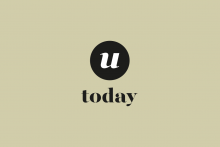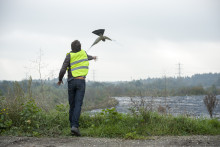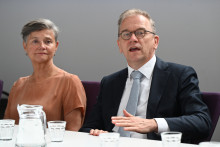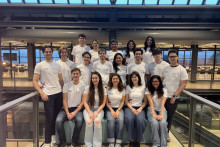The tall native Australian has been involved in the area of urban planning and management for almost all of his life, working for the ITC for 26 years, and earning his PhD in the subject at the University of Utrecht.
The first connection the associate professor had with the Istanbul Metropolitan Muncipality Planning and Urban Design Center (IMP) was back in 2007, when he initially met Dr Gürcan Büyüksalih. The two men had a mutual interest to set up and manage a conference in Istanbul in 2008, which involved bringing together members of the European Association of Remote Sensing Laboratories (EARSeL), a scientific network of European remote sensing institutes with people from the GIS in developing countries network (GISDECO) and others working in the commercial and industrial sectors.
This contact was the precursor for a new opportunity to send six students on fieldwork at the IMP. ‘Last year we received students who were sponsored by the EU. It was only after they started did we realize there were all kinds of restrictions about where they were allowed to conduct fieldwork,’ said Sliuzas. Regretfully, the scholarship program allowed for research only in European Union countries, leaving Turkey’s non-EU membership status as an obstacle.
But in the end, their plan was given a green light. ‘I checked to find out if we could send students to Turkey and then I contacted Gürcan who was keenly interested in exchanging knowledge,’ said Sliuzas who felt enthusiastic about the chance to conduct fieldwork in Istanbul because he had never worked in the Turkish context.
Many staff members in his department run projects in developing countries, said Sluizas, but never Turkey, making it more of an uncertainty. ‘Basically, we had nothing before the trip beside a letter stating, “You are welcome. Come.”.’ Though one staff member, Dr Javier Martinez who is an associate professor went on an initial preparatory trip to evaluate the facilities and feasibility in the summer of 2009.
At the time of the students’ departure to Istanbul, a major flood had swept through the seaside area, a sign of the vulnerability of region and the need for future research efforts to limit the impact of natural disasters. ‘The students were nervous and things were a bit uncertain,’ said Sliuzas. ‘Normally speaking, we had hoped once we’d secured an agreement with IMP and knew the students would go there, we’d get data for analysis before they left on the trip.’
The first step for the six ITC students on the 18-month master’s track was to define their thesis topic and work on analyzing data for two months prior to conducting actual fieldwork in Istanbul, where the IMP provided a good learning environment and was equipped with the latest technologies.
Eventually, the collaboration with Istanbul could possibly have an influence on urban planning for the whole city. A main interest of the ITC is to see how urban models can be used in the most efficient way to add value to the planning process. Sliuzas suggested these models can simulate possible development scenarios, giving an insight into the impact of a particular urban planning project for cities around the world.
In the long term, Sliuzas and his ITC colleagues are working towards further development and improvement of modeling capacity in order to have a tighter integration between land use development and transportation planning. He recognizes the importance of having urban planning models that make accurate predictions, and with the use of advanced technologies the modern-day urban planner can make sound decisions. ‘We’d like to better understand what the relationships are so hopefully we can attune the two systems to work better together. That is the ultimate goal.’
 |
| Standing in the three-dimensional logo of the ITC, from left to right, Dutch associate professors, Dr Johannes Flacke and Dr Richard Sliuzas, next to guest visitor Dr Gürcan Büyüksalih. ‘While Gürcan is in the Netherlands,’ said Sliuzas, ‘We will discuss the possibilities for the next research fieldwork in Istanbul. We made an initial agreement for two years to see if it’s feasible or not, and the ideal is to see whether we can find other forms of cooperation. We hope to get funding for joint research projects at a higher level, involving students at the PhD level and examining other topic areas.’ |







